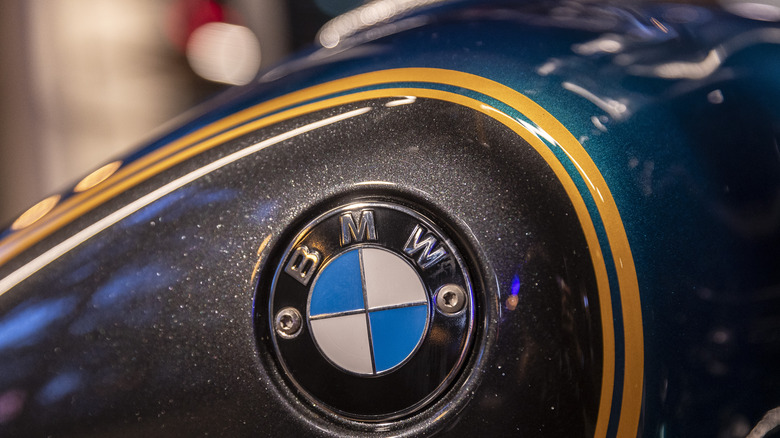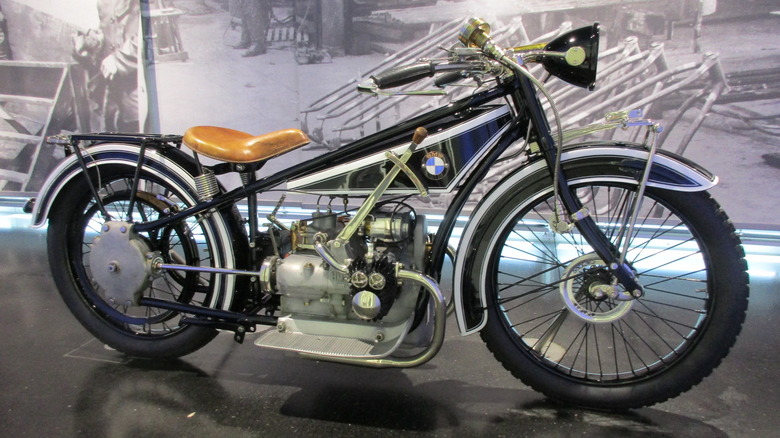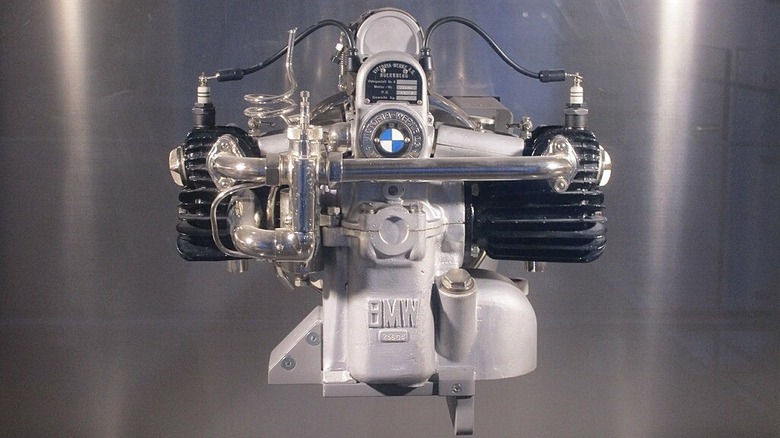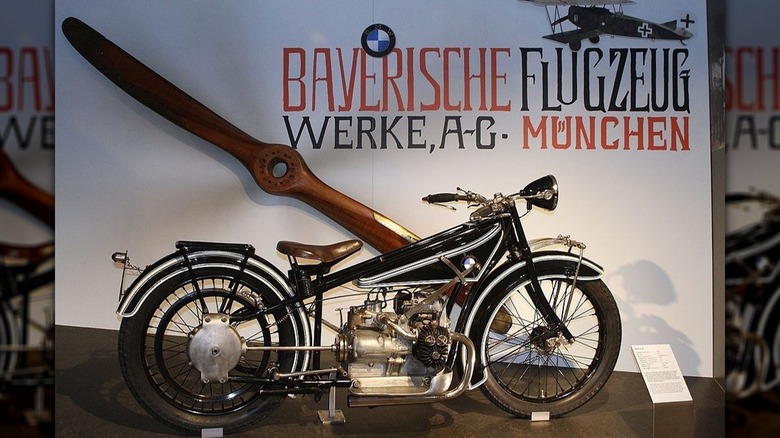What Made BMW's Original Motorcycle So Cool Over 100 Years Ago
Today, the BWM is synonymous with automotive excellence. But what most people probably don't realize is that when the company started, it was neither called Bavarian Motor Works nor did it have anything to do with automobiles, much less motorcycles.
BMW began taking shape near the turn of the 20th century with two men — Karl Rapp and Gustav Otto. In 1911, Otto opened a "flying machine factory" in Munich named Otto-Werke, and Rapp started Rapp-Motorenwerke GmbH in 1913 to build aircraft engines. Over the next few years, several meandering business machinations (spurred by World War I) eventually melded these two men and their respective companies. BMW views March 7, 1916, as the official date of its founding, and its iconic blue and white logo (the state colors of Bavaria) created in 1917 is a symbolic representation of a rotating propeller.
When WWI ended and the Treaty of Versailles was signed (June 1919), Germany was slapped with a "war guilt" clause that forced it to take all the blame for the war. Among the repercussions was a total halt on the production of all weapons of war, including planes and airplane engines.
In 1922, still banned from making planes or engines, BMW began building motors for agricultural equipment, boats, trucks – and motorcycles. In 1923, it unveiled the first of many BMW-badged motorcycles at the Berlin Motor Show (not in Paris as was once believed). But, as was the case with most things BMW in those early days, the story of how that happened also took a convoluted path.
BMW's first motorcycle
But that story begins in January 1917, when Max Friz, a 33-year-old engineer, left his job at Austro-Daimler (the very same company Rapp contracted to build airplane engines a few years earlier) and was quickly snatched up by BMW. It didn't take Friz long to become the company's head designer.
Ironically, Friz hated motorcycles. To be fair, he hated cars, too. In fact, he considered anything that wasn't an airplane to be "stupid conveyances." Despite the attitude, Franz Josef "Karl" Popp, who'd been brought in to manage the company a few years earlier, somehow persuaded Friz to build motorcycle engines and, soon after, began making them for other companies.
Friz started with a portable industrial engine already in the works and converted it into a 486cc four-stroke boxer twin-cylinder motor (known as M2B15) that was subsequently used by both Victoria Werke AG in Nuremberg as well as BFW (remember them?) where Gustav Otto (remember him?) was working on a big bike called Helios.
In November 1922, Popp ordered Friz to build BMW's first badged bike. Four weeks later, Friz had designed a full-scale version, the R32, complete with what would become BMW's signature flat twin "Boxer" engine using the knowledge he had obtained from his years building aircraft engines.
[Featured image by Arnaud 25 via Wikimedia Commons | Cropped and scaled | CC BY-SA 4.0]
This innovative Bavarian engine purred
The finned cylinder heads stuck out sideways from the block, or as BMW put it, were "mounted transverse to the direction of motion," which naturally air-cooled them. Not only that, but Friz rotated the engine 90 degrees, allowing for a shorter and more practical wheelbase.
The R32 used a shaft drive so the crankshaft could be mounted lengthwise, allowing the 3-speed transmission to line up precisely with the engine. The fully encased drive shaft turned the rear differential, providing power directly to the back wheel. Ditching the drive chain or belt made repairs easier.
Other groundbreaking features included an automatic recirculating wet sump system instead of the total-loss oil system used by other bike builders. A wet sump uses the bottom of the engine as a built-in oil reservoir instead of an external one, like in a dry sump system. Additionally, parts likely to break down were encapsulated, which provided extra protection and a longer life.
The Boxer kicked out 8.5 hp, reaching a top speed of almost 60 mph. The R32 was produced from '23 through 1926 and sold nearly 3,000 units. They were in such high demand that two fully loaded models were exported to Japan in 1924. That may not sound like a big deal today, but the lighting system, horn, and speedometer cost extra and weren't standard until 1930. Additionally, the Bavarian city of Kaufbeuren ordered one with a sidecar to use in its fire department.
[Featured image by Arnaud 25 via Wikimedia Commons | Cropped and scaled | CC BY-SA 4.0]
BMW's long journey from the sky to the road proves successful
BMW began improving on the R32 when Rudolf Schleicher (a motorcycle racer and engineer at BWM) took over the reins and designed a new cylinder head made of a new light alloy with suspended valves. The successor was the R37, and had a 500 cc engine with 16 hp, nearly double that of the R32.
It almost immediately became the engine of choice with professional motorcycle racers around the world. For the next five years (from 1924 to 1929), a rider atop a BMW motorcycle won every German Championship in the 500 cc division.
The company didn't start dabbling with cars until 1928 when it bought out Fahrzeugfabrik Eisenach. Its first small car was built under a license from the Austin Motor Company in 1929, and in 1933, it rolled out its first wholly in-house designed BMW — the 303. BMW, which technically began making airplane motors way back in 1911, continued to do so until the end of World War II in 1945.
Believe it or not, Friz's basic R32 design was used until BMW introduced the /5 series in 1969. The transverse-mounted cylinders and cardan shaft drive proved so successful that both are still in use today. In fact, the original shaft drive design didn't change at all until the launch of BMW's F650 in 1994. Now, if that doesn't define long-lasting success ... we don't know what does.
[Featured image by Dirk Godlinski via Wikimedia Commons | Cropped and scaled | CC BY-SA 3.0]



